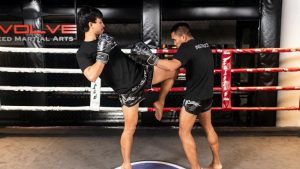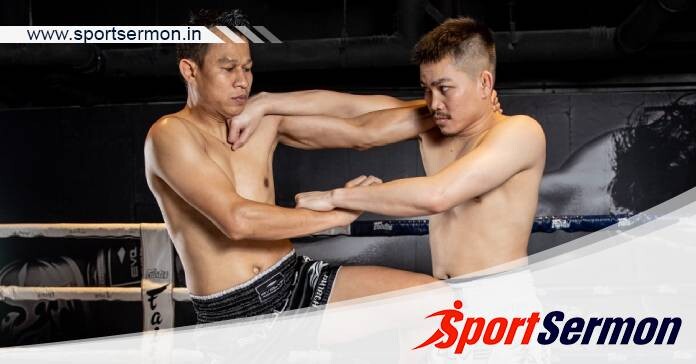Muay Thai Knee Guard: In Muay Thai, competitors seek out strategies to strengthen their defences and retain dominance over their opponents. The knee guard is one such method that has become very popular. Following a knee strike, the same-side leg is raised and placed across the opponent’s torso in a transitional manoeuvre known as the knee guard.
In addition to providing defence against counterattacks, this tactical guard posture offers possibilities for follow-up strikes and manages the fight’s flow.
Understanding This Transitional Move Is Important
Any Muay Thai fighter who wants to thrive in the clinch and take advantage in the ring must master the knee guard. It protects against any reprisal from an adversary following a knee attack and acts as a springboard for offensive moves. Fighters may assert control in close-quarters fighting, neutralise their opponents’ assaults, and open up blow opportunities by skillfully employing the knee guard.
Understanding The Knee Guard
You must comprehend the mechanics and underlying technique of the Muay Thai knee guard to really appreciate it. The knee guard entails elevating the leg from the same side as the knee strike and placing it across the body of the opponent. By doing this, a physical barrier is created that hinders the opponent’s mobility and protects them from incoming blows.
Balance, stability, and core strength are required for the knee guard. A strong foundation is provided by the supporting leg, and control is maintained by focusing on the knee. For increased stability, the fighter’s arms might be placed in a clinch position or clasping the opponent’s arms.
You might also be interested in reading this: Get To Know Everything About Muay Thai Dracula Guard
Important Ideas And Body Positions For Successful Execution
Proper body alignment and attention to a number of fundamental rules are necessary for carrying out the knee guard efficiently. Here are some crucial factors to remember:
- Balance And Stability: Maintaining a solid foundation and a secure posture are essential. Engage your core, distribute your weight evenly between your legs, and maintain a straight upper body.
- Active Guarding: Press your knee guard firmly into your opponent’s body to apply pressure. They are actively hindered by this, which makes it harder for them to mount a successful response.
- Counterbalance: Use your non-supporting hand to grab your opponent’s arm or shoulder in order to provide a counterweight against their attempts to unsettle you and improve balance and stability.
- Head Positioning: Maintain a straight back and an erect posture with your head. This keeps your opponent from establishing superior placement and helps you stay aware of your surroundings.
- Weight Distribution: Balance your weight evenly between your legs. While too much weight on the rear leg restricts movement, too much weight on the front leg might affect balance. Achieve the ideal balance between fast changes and strong defence.
Following these guidelines and keeping your body in the right position will help you perform the knee guard precisely and make the most of its defensive potential during a fight.
Differentiating The Knee Guard In Muay Thai From Other Guard Positions

It’s vital to understand that the knee guard differs from other often utilised guards like the classic high guard or low guard in Muay Thai. While the knee guard has a similar defensive function, it focuses on the period immediately following a knee strike to give the fighter a smooth transition from offence to defence.
The knee guard is a dynamic position that necessitates continual modifications and agility, in contrast to static guards like the high guard or low guard. Setting the groundwork for future follow-up strikes or defensive manoeuvres, it helps the fighter to maintain control and preparedness for additional engagement.
A strong basis for learning this transitional technique is having a thorough understanding of the particular mechanics, guiding principles, and distinguishing characteristics of the knee guard in Muay Thai.
Defensive Advantages Of The Knee Guard
- Protection from Counterattacks: The knee guard protects you from an opponent’s quick counterattacks after a knee strike and is a powerful defensive tool. By placing your leg over their body in a horizontal stance, you may block attacks and prevent them from mounting a successful offensive reaction.
- Control in the Clinch: A key component of Muay Thai, control in the clinch, is made possible by the knee guard. You can successfully counteract your opponent’s attempts to establish dominating placement and restrict their capacity to launch blows or commence grappling manoeuvres by employing the knee guard.
Opportunities For Offence Provided By The Knee Guard
Follow-Up Strikes: The knee guard prepares the ground for lethal follow-up attacks. You may swiftly go from defence to offence by using the knee guard as a transitional posture and taking advantage of your opponent’s weakened position. The knee guard allows you to throw strikes like elbows, punches, or kicks with ease, surprising your opponent and dealing serious harm.
Sweeps And Throws: The knee guard presents chances for sweeps and throws as well. You may successfully sweep or throw your opponent to the ground and take control of the situation by making use of your stability and control in the knee-guard position.
A Muay Thai practitioner’s knee guard is a useful tool because of its adaptability in both defence and offence. Along with control and protection, it creates space for deadly attacks and grappling manoeuvres.
Exercises For Conditioning That Strengthen The Legs And Core For Stability
- Variations of the plank: The core stability required to maintain stability in the knee guard is developed via the practice of the plank. To exercise your core muscles, combine basic planks with side planks and plank variants like plank leg lifts.
- Squats and lunges: These are workouts that concentrate on working the quadriceps, hamstrings, and glutes in the legs. Strong leg muscles provide the knee guard its stability and force.
Exercises To Improve Rapid Transitions Into The Knee Guard
- Strike Combinations: Practise moves that end in a knee, such as hook-uppercut-knee and jab-cross-knee. Concentrate on smoothly moving from a strike to the knee guard posture following the strike.
- Mirror drills: Practise knee strikes and the switch to the knee guard posture while taking turns with a partner. Try to go from an attack to a guard with ease, while working on your speed and precision.
- Knee Guard Transitions in Shadowboxing: Include knee guard transitions in your shadowboxing practice. Imagine an opponent striking you, then practise using the knee guard to defend yourself.
Exercises With A Partner That Simulate Actual Combat Situations And Improve Timing
- Clinch Training: Work on clinch drills with a partner, emphasising the use of the knee guard as a defensive technique. Control your partner’s movements, hold the knee guard stance, and use opportunities to respond with blows or sweeps.
- Counterattack Drills: Putting yourself in the knee guard position to defend against various blows and attacks while having your partner copy you. Use the knee guard to deflect and block your own blows as you respond quickly and effectively.
The physical skills, timing, and fluidity needed to perform the knee guard well in actual combat situations may be developed by regular practice with these conditioning drills and exercises. By adding these training techniques into your routine, you’ll improve your knee guard skills and Muay Thai performance as a whole.
Utilisation and Plan

The Muay Thai knee guard has been effectively used by professional fighters to gain an advantage in the heat of combat in the real world. Fighters can defend against counterattacks, manage the flow of the fight in the clinch, and take advantage of offensive openings by using the knee guard efficiently.
Reading opponents, timing the knee guard, and modifying it for various opponents and battle settings are all techniques for incorporating the knee guard into one’s general fighting approach. A fighter’s effectiveness and capacity to dominate opponents may be greatly improved by comprehending these tactics and using them in the ring.
Conclusion
Understanding the mechanics and technique of the knee guard, adhering to basic principles of balance and stability, and differentiating the knee guard from other guard positions are essential skills for every Muay Thai practitioner. Fighters may maximise their defensive advantages and attacking potential by mastering these skills.
Practitioners can build the essential abilities and timing to perform the knee guard with ease through conditioning exercises, drills for fast transitions, and partner training activities. With its adaptability and efficiency, the knee guard develops into a potent weapon in a fighter’s toolbox, offering safety, control, and chances for deadly punches and grappling manoeuvres.
Accept the knee guard, train with it, and raise your Muay Thai game.
This is a complete guide to Muay Thai Knee Guard. Let us know your thoughts in the comment section below.

